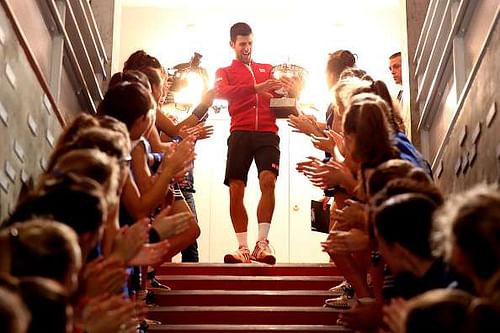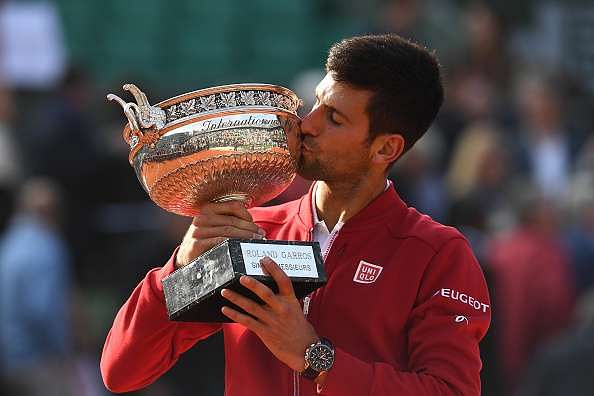
Novak Djokovic: Going where no man has gone before
If you’re a Novak Djokovic fan, you’ve probably envisioned several times what it would look like when the Serb finally won the French Open. I don’t particularly consider myself a Djokovic fan, but even I’ve had the mental picture pop into my head on more than one occasion. Breaking into an impromptu war dance, Gangnam-style? Going down on his knees and biting the clay, as he’s done at Wimbledon (with the grass) a few times? Tearing his shirt apart and screaming at the skies, a la Australian Open 2012?
As it turns out, it was a much more ho-hum reaction. After Djokovic defeated Andy Murray 3-6, 6-1, 6-2, 6-4 to win his first French Open title, he fell flat on his back but looked surprisingly even-keeled. He didn’t even spend much time down there, springing up almost immediately and jogging to the net for the customary post-match handshake.
Maybe it took some time to sink in. Career Grand Slam, four Majors in a row, total dominance of the sport – that’s not your everyday sort of accomplishment. In fact, it’s not even your every-year or every-decade sort of accomplishment; the last man to win four Majors in a row, as you’ve probably heard, was Rod Laver back in 1969.
Eventually it did sink in, just as it did for the millions of us watching. Djokovic started to show signs of breaking down after locking eyes with his family, and he whirled around to face the crowd, staggering on the court like he was drunk. He then steadied himself a bit to dance and wave with the ball girls – how could The Djokovic Show ever be complete without a bit of dancing?
There was one final gesture to be showcased though. Djokovic ran back to his chair and curiously grabbed hold of his racquet, making us wonder whether the shock of the win was so great that he felt he still had to play some more tennis. Fortunately, that wasn’t what it was. With three-time French champion Gustavo Kuerten looking on from the stands, Djokovic drew a gigantic heart into the clay with his racquet and lay down in the centre of it, bringing back memories from a decade ago.
The World No. 1’s post-match celebration had a bit of everything. That’s just as well, considering how his game has a bit of everything too. And that game was on point all the way from the start of the second set until the end of the fourth, when Murray finally caved in.
Djokovic’s ultimate victory will probably reduce the first set of the match to a distant memory, and that’s a good thing. That first frame wasn’t memorable by any stretch of the imagination; no matter how the partisan Eurosport commentators may have tried to spin it, Murray didn’t really do anything special to win it. Djokovic, visibly weighed down by the pressure and the expectations, threw in a stinker of a set after breaking Murray in the opening game, and the words ‘choke’ and ‘jinx’ started crossing my mind.
At the end of the set though, something happened that may well be considered the turning point that shaped Djokovic’s conquest of the Final Frontier. Murray, serving for the set at 5-3, hit a deep second serve that was called out by the linesman. Djokovic sent the return long, but the chair umpire overruled and handed the point to Murray. Whether Djokovic had completed his swing before or after the ‘out’ call came was debatable; the Serb was convinced that the call had come earlier, and was furious that the umpire ruled in Murray’s favour.
Was that the spark that Djokovic needed to get out of his funk? It’s been said a lot of times that Djokovic needs to be on edge to produce his best tennis. Although I’m not sure whether that’s always true (exhibit A: Djokovic’s win over Roger Federer at the 2016 Australian Open, where the Serb was ridiculously calm and unbelievably brilliant all through the match), the altercation certainly seemed to free up Djokovic’s strokes a little today.
He still lost that game, and with it the set, but there was a newfound energy to Djokovic’s game at the start of the second. He saved a break point in the opening game with an authoritative rally, and proceeded to break Murray the very next game – finally getting some momentum in the match. He never looked back from there, winning 15 of the next 20 games to reach 5-2 in the fourth set, finally in a position to serve for the Roland Garros Championship.
Throughout that 20-game run, Murray looked like he’d much rather be anywhere but on the court. As a long-suffering Murray fan I have learned to expect sudden downswings in his form and body language, but even I struggled to comprehend why the Scot would go so miserably down on himself despite having one set in the bag.
Almost immediately after he was broken in the second set Murray started looking morose and irritated, glaring repeatedly at everything from the ball to the court to his racquet – as if they were responsible for his passive play. He looked more like a petulant school boy and less like a world-class tennis player, and I for one found it incredibly hard to watch.
Even his movement started looking ragged, which is the last thing you want to happen while playing against Djokovic. I’ve had troubles with my TV feed all tournament, and several times today I thought the telecast had frozen when Murray was running for the ball. But it didn’t take me long to realize that there was no problem with the feed; it was just the fact that Murray was much slower on the court than Djokovic.
That’s what Djokovic can do; he can make even the fastest of movers appear slow and sluggish by comparison. And that’s not just because the Serb himself is so quick; it’s also because his underrated offense can take time away from his opponent in a big way.
Murray seemed to have decided that out-defending Djokovic was his best bet of winning the match, and for the moment let’s just leave aside how stupid that strategy sounds. The significant fallout of the Scot’s approach is that it convinced Djokovic to go on the offense, which is never good news for his opponent. By the middle of the match the Serb was firing his returns to every inch of the baseline, and Murray could only labour futilely in pursuit, grunting with every step and making tennis look like the most physically demanding activity in the history of mankind.
The match wouldn’t end before some late drama though, as Murray suddenly found a second wind with Djokovic serving at 5-2 in the fourth. He broke to 15 and then held to 15, before saving two match points as the crowd (which was pro-Djokovic all the way) roared in exasperation. It was hard not to get a sense of deja vu; when Murray was serving for the Wimbledon title back in 2013, it was Djokovic who had pushed back at the very last hurdle, making life very, very stressful for the would-be first-time champion.
But just like in 2013, the better player on the day eventually got to the finish line. Djokovic refused to let his prize out of his grasp when he was so close, and on the last point he showed once again why he is the best player in the world. He returned everything that Murray threw at him, until the Scot could finally take it no more; looking to end the point, Murray went for an almighty flat crosscourt backhand that could only find the net.
Just like that, Djokovic was the French Open champion. All that talk of a jinx, all that heartbreak at the hands of Rafael Nadal, all that battering his racquet had to suffer against Stan Wawrinka last year – everything that had stood in his way had been banished, and he was now the unquestioned King of the World. Could it get any better than this?
The statisticians and record-keepers will say that Djokovic still hasn’t emulated Rocket Rod. The ‘true Grand Slam’ means winning all four Majors in a single calendar year, and Djokovic is still two Slams away from getting there.
To that I say: nonsense. The difference in Laver’s 1962/1969 and Djokovic’s run starting from last year’s Wimbledon is a mere technicality. Winning four Majors in a row is incredibly, almost unimaginably difficult, and to me it is the ultimate achievement in tennis. What Djokovic has just done surpasses anything that any man has done since 1969.
In fact, I might even be tempted to say that Djokovic has superseded Laver too – the Serb’s victories have come on three different surfaces, while Laver won his four on just two (grass and clay).
This is an Olympic year, which means Djokovic now has the chance to win the almost mythical Calendar Golden Grand Slam. No man has ever even come close to this feat, and only one woman has done it: Steffi Graf in 1988. If Djokovic gets it done this year, should we start calling him the Greatest Of All Time? Is he the GOAT already?
Yes, I get it. The debate will never end, and probably shouldn’t be had at all until the Big 3 have retired. But I just find it very amusing that the question has been raised after almost every Slam this past decade. It’s an under-statement to say that the current tennis audience is incredibly privileged; future generations will look back on this era and wonder, with their mouths open in amazement, how three Career Slammers could possibly have played at the same time.
“I’m proud to be a part of it”. That’s what Murray said in his post-match speech, referring to Djokovic’s achievement while struggling to hold back his tears. But it’s a sentiment that holds true for everyone; as tennis watchers we are all proud to be a part of this era too, and privileged to be witnessing the Age of Novak live.
It’s an age unlike any other in the history of tennis. Who would’ve thought a career that started with Gangnam-style dance celebrations and Djoker-like impersonations of fellow players would reach a peak so dizzyingly high that it would eclipse everything else in sight?
I won’t ask Novak to ‘take a bow’; instead, we should all be bowing before him. He is the King, after all.


